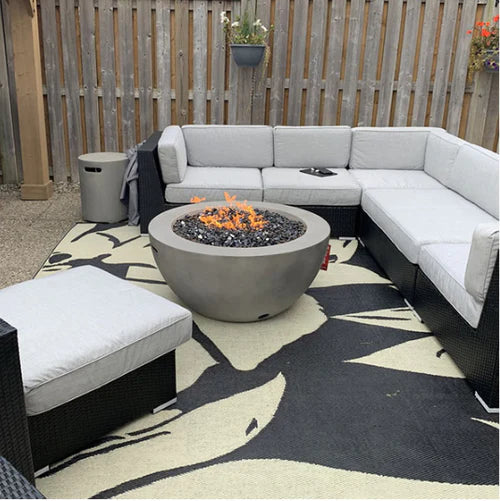Looking for a project to enhance your outdoor living space? Building your own Adirondack chair is a great way to add both comfort and style to your patio, deck, or backyard. With a few tools, some basic woodworking skills, and a bit of patience, you can create a sturdy and attractive piece of outdoor furniture that will last for years to come. In this article, we will provide you with step-by-step instructions on how to build your own Adirondack chair.
The Adirondack chair is a classic outdoor chair design that has been popular for over 100 years. It was originally created in 1903 by Thomas Lee, a resident of the Adirondack Mountains in New York. Lee wanted a chair that was comfortable, durable, and would look great in the rugged mountain landscape. He created a design that featured wide armrests, a high back, and a slanted seat and backrest, which allowed for maximum comfort and relaxation.
Today, the Adirondack chair is still a popular choice for outdoor furniture, and it can be found in a variety of materials, including wood, plastic, and metal. However, if you are looking for a truly customizable option, building your own Adirondack chair is the way to go.
Tools and Materials
Before you start building your Adirondack chair, you will need to gather the necessary tools and materials. Here is a list of what you will need:
- Circular saw
- Jigsaw
- Drill
- Screwdriver
- Hammer
- Clamps
- Sandpaper
- Tape measure
- Pencil
- Safety glasses
- Dust mask
- Wood glue
- Outdoor wood screws (2 1/2 inches and 3 inches)
- Outdoor wood stain or paint
- 2 cedar boards (1x6x8 feet)
- 1 cedar board (1x4x8 feet)
Step-by-Step Instructions
Once you have your tools and materials, you are ready to start building your Adirondack chair. Follow these step-by-step instructions:
Step 1: Cut the Cedar Boards
Using a circular saw, cut the two 1x6 cedar boards into the following pieces:
- 2 pieces measuring 33 inches (front legs)
- 2 pieces measuring 22 inches (back legs)
- 2 pieces measuring 20 inches (armrests)
- 2 pieces measuring 24 inches (front aprons)
- 2 pieces measuring 23 inches (back aprons)
- 1 piece measuring 22 inches (front crosspiece)
- 1 piece measuring 23 inches (back crosspiece)
- 4 pieces measuring 20 inches (seat slats)
- 3 pieces measuring 24 inches (back slats)
Using a jigsaw, cut the 1x4 cedar board into the following pieces:
- 2 pieces measuring 19 inches (armrest braces)
- 2 pieces measuring 17 inches (back braces)
Step 2: Sand the Wood
Sanding the wood is a crucial step in preparing it for the construction of your Adirondack chair. Not only does sanding make the wood look smoother and more polished, but it also helps to remove any rough spots or imperfections that may cause discomfort when sitting on the chair.
To start, you'll need a few sanding tools, such as sandpaper, an electric sander, and a sanding block. The grit of the sandpaper you use will depend on the type of wood you're working with and how smooth you want the final result to be. In general, a grit between 80-120 is good for rough sanding, while a grit between 150-180 is suitable for finishing.
Begin by sanding the rougher areas of the wood with the rougher grit sandpaper. Sand in the direction of the wood grain, using firm but not excessive pressure. Once the rough areas have been smoothed down, switch to the finer grit sandpaper and continue sanding until the wood feels smooth to the touch.
When using an electric sander, be sure to keep it moving at a steady pace and avoid applying too much pressure in one spot, which can cause uneven sanding. A sanding block can also be used to manually sand hard-to-reach areas or curves on the wood.
Once you're satisfied with the level of smoothness and the absence of any rough spots, wipe down the wood with a damp cloth to remove any sawdust or debris. You're now ready to move on to the next step in building your own Adirondack chair.
Step 3: Assemble the Seat
Now that the backrest is complete, it’s time to move on to the seat. First, you’ll need to assemble the seat base. Take two of the 22-inch pieces you cut earlier, and place them parallel to each other on a work surface, with the flat sides facing up and the angled sides facing each other. These pieces will form the front and back of the seat base.
Next, take two of the 19-inch pieces and place them perpendicular to the front and back pieces, with their flat sides facing down. These pieces will form the sides of the seat base. Use wood glue and screws to attach the sides to the front and back pieces.
Once the seat base is assembled, it’s time to attach the seat slats. Start by measuring the distance between the sides of the seat base. This measurement should be just slightly less than the length of the seat slats. Cut the seat slats to the appropriate length and lay them out on top of the seat base, leaving a small gap between each slat.
When you’re happy with the positioning of the slats, use wood glue and screws to attach them to the seat base. Make sure to countersink the screws so they don’t stick out above the surface of the slats.
Step 4: Attach the Backrest to the Seat
With both the backrest and seat complete, it’s time to attach them to each other.
To attach the backrest to the seat, you will need the previously cut and sanded backrest piece and the assembled seat.
Place the backrest piece on top of the seat with the bottom of the backrest facing the ground and the angled top facing upwards. Make sure the top edges of the backrest are flush with the top of the seat. Then, measure and mark the placement of the backrest on the seat. Typically, the backrest will sit about 2 inches from the back edge of the seat.
Apply a thin layer of wood glue to the bottom of the backrest piece where it will make contact with the seat. Now, carefully position the backrest piece back onto the seat, making sure to align the marks you made in the previous step. Use the drill to secure the backrest to the seat with screws. Begin by drilling a pilot hole through the seat and into the backrest piece, then insert the screws and tighten them down. Repeat this process for each screw hole.
Flip the chair over and check that the backrest is securely attached to the seat.
Congratulations, you have now successfully attached the backrest to the seat! You are almost done with building your Adirondack chair.
Step 5: Attach the Armrests
The final step is to attach the armrests to the chair. Start by cutting two pieces of wood to the same length as the front and back pieces of the seat base (22 inches). These pieces will form the front and back of the armrests.
Next, cut two more pieces of wood to the same length as the sides of the seat base (19 inches). These pieces will form the sides of the armrests. Use wood glue and screws to attach the sides of the armrests to the front and back pieces. Then, position the armrests on the sides of the chair and attach them to the backrest and seat using wood screws.
Step 6: Sand and Finish the Chair
Once the chair is fully assembled, it’s time to sand and finish it. Start by sanding all of the rough edges and surfaces with a coarse sandpaper. Then, switch to a finer grit sandpaper and sand the entire chair until it is smooth to the touch.
Next, choose a finish for the chair. You could paint it, stain it, or simply seal it with a clear coat. Whatever you choose, make sure to apply the finish in a well-ventilated area and follow the manufacturer’s instructions.
Step 7: Enjoy Your Adirondack Chair
Congratulations, you’ve completed your DIY Adirondack chair! Now it’s time to enjoy the fruits of your labor.
Find a nice spot in your backyard, patio or garden to place your new chair. Take a seat and relax while enjoying the beautiful outdoor scenery. You may want to add some cushions or pillows to make it even more comfortable.
Remember that you can always customize your Adirondack chair by painting it or staining it to match your outdoor decor. You can also experiment with different types of wood or even add some accessories, such as a cup holder or a footrest.
Finally, don't forget to take care of your new outdoor furniture. Regularly clean it with a mild soap and water solution and protect it from harsh weather conditions by covering it with a waterproof cover when not in use.
Building your own Adirondack chair is a fun and rewarding DIY project that can be completed over the course of a weekend. By following the steps outlined in this article, you can create a comfortable and attractive piece of outdoor furniture that will last for years to come.
Remember to take your time and use caution when working with power tools and sharp objects. Always wear protective gear, such as safety glasses and gloves, to prevent injury.
Once you've built your Adirondack chair, you can customize it to your liking with paint or stain. You can also add cushions or pillows for extra comfort. Not only will you have a beautiful new piece of furniture for your outdoor space, but you'll also have the satisfaction of knowing that you built it yourself. So, gather your materials, get to work, and enjoy the process of building your own Adirondack chair.














